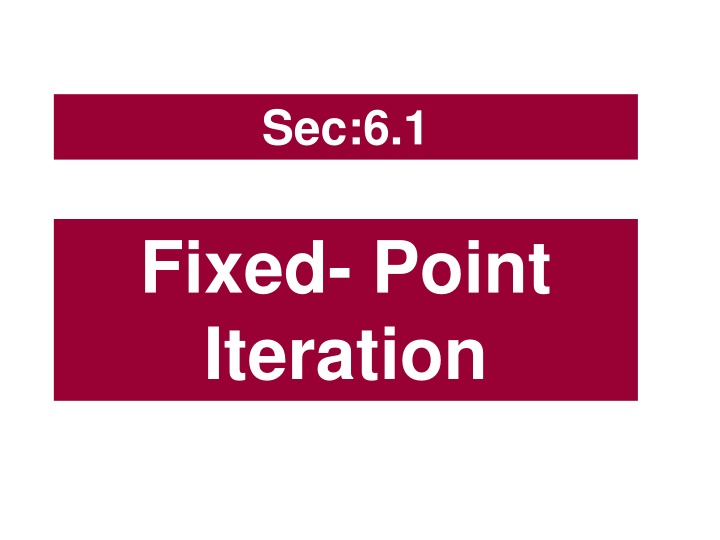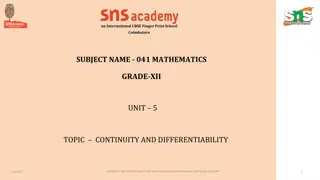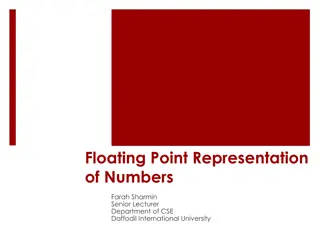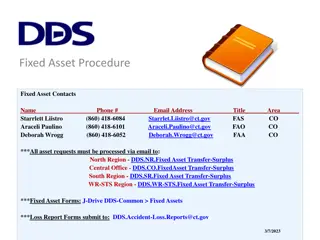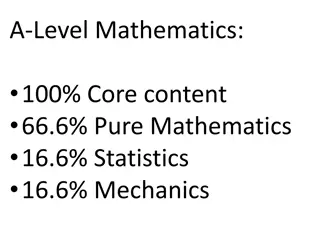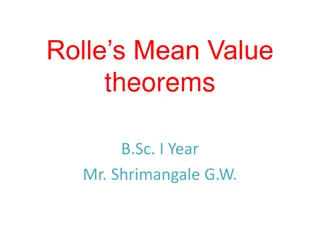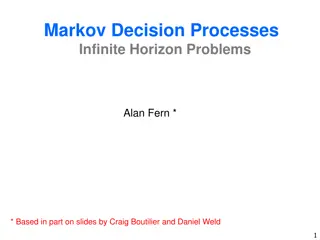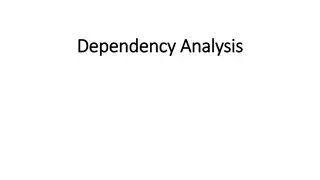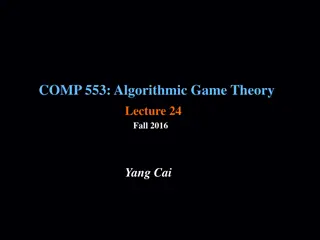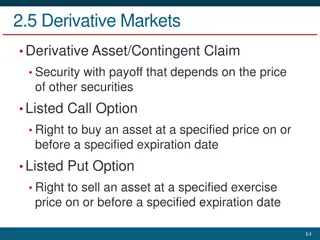Fixed-Point Iteration in Mathematics: Understanding the Derivative Mean-Value Theorem
Concept of fixed-point iteration in mathematics through examples and explanations, including the derivative mean-value theorem. Learn how to locate roots using iterative methods and understand the importance of fixed points in mathematical functions.
Download Presentation

Please find below an Image/Link to download the presentation.
The content on the website is provided AS IS for your information and personal use only. It may not be sold, licensed, or shared on other websites without obtaining consent from the author.If you encounter any issues during the download, it is possible that the publisher has removed the file from their server.
You are allowed to download the files provided on this website for personal or commercial use, subject to the condition that they are used lawfully. All files are the property of their respective owners.
The content on the website is provided AS IS for your information and personal use only. It may not be sold, licensed, or shared on other websites without obtaining consent from the author.
E N D
Presentation Transcript
Sec:6.1 Fixed- Point Iteration
1) Online Computing 2) MATLAB workshop 2) Exam-I and Exam-II Exam-I Date: Oct 19 Exam-II Date: Oct 23 Time: two hours between 5PM-10PM
Sec:6.1 Fixed- Point Iteration The number ? is a fixed point for a given function ? if. ? = ? ? Example: A fixed point for g occurs precisely when the graph of ? = ?(?) intersects the graph of ? = ? Determine any fixed points of the function ?(?) = ?2 2. solution ? = ?(?) ? = ?2 2 0 = ?2 ? 2 ? = 1,? = 2
Sec:6.1 Fixed- Point Iteration The derivative mean-value theorem states that if a function ?(?) and its first derivative are continuous over an interval ? ? ?, then there exists at least one value of ? = ? within the interval such that ? ? ? ? = ? ? (? ?) ?(?) ?(?) ? ? ? (? ) = The right-hand side of this equation is the slope of the line joining ?(?) and ?(?). Slope of the tangent line is ? (? ) Slope of this line is ?(?) ?(?) ? ? ?
Sec:6.1 Fixed- Point Iteration Example1 simple fixed-point iteration ?2 2? + 3 = 0 Step 1 can be simply manipulated to yield ? =?2+ 3 rearranging the function 2 ? = ?(?) ? (?) = ? so that x is on the left-hand side of the equation: ? = ?(?) (*) Example2 sin(?) = 0 can be simply manipulated to yield ? = ? + sin(?) ? = ?(?) Step 2 given an initial guess at the root ??, (*) can be used to compute a new estimate ??+1as expressed by the iterative formula Note Convert the problem from root- finding to finding fixed-point ??+?= ?(??)
Sec:6.1 Fixed- Point Iteration Step 1 Example1 Use simple fixed-point iteration to locate the root of rearranging the function ? = ? ? ? = ?(?) ? ? = ? ? ? ?? ? Step 2 1 0.0000000000000 2 1.0000000000000 3 0.3678794411714 4 0.6922006275553 5 0.5004735005636 6 0.6062435350856 7 0.5453957859750 8 0.5796123355034 9 0.5601154613611 10 0.5711431150802 11 0.5648793473910 12 0.5684287250291 ??+?= ?(??) ??+?= ? ?? Starting with an initial guess of x0 = 0 = ? ?= ? ??= ? ?? = ? ?= 0.367879 ??= ? ?? = ? ?.??????= 0.692201 ??= ? ?? Thus, each iteration brings the estimate closer to the true value of the root: 0.56714329
Sec:6.1 Fixed- Point Iteration ?? ?? ?? clear; clc; format long x(1) = 0; g = @(x) exp(-x); f = @(x) exp(-x) - x; true_root = 0.56714329; for k=1:11 x(k+1) = g( x(k) ); end e_t = 100 * abs( x - true_root ) ./ true_root; res = [[1:12]' x' e_t']; fprintf('%d %16.13f %16.13f\n', res'); ??= ???% ??(%) ?? ? 1 0.0000000000000 100.00 2 1.0000000000000 76.32 3 0.3678794411714 35.13 4 0.6922006275553 22.05 5 0.5004735005636 11.75 6 0.6062435350856 6.89 7 0.5453957859750 3.83 8 0.5796123355034 2.19 9 0.5601154613611 1.23 10 0.5711431150802 0.70 11 0.5648793473910 0.39 12 0.5684287250291 0.22 Notice that the true percent relative error for each iteration is roughly proportional (by a factor of about 0.5 to 0.6) to the error from the previous iteration. This property, called linear convergence
Convergence Sec:6.1 Fixed- Point Iteration Suppose that the true solution is ??,?+?= ? ? ??,? ??= ?(??) < ??,? ( If ? ? the iterative equation is < ? ) the errors decrease with each iteration ??+?= ?(??) Subtracting these equations yields ??,?+? < ??,? ?? ??+?= ? ?? ?(??) The derivative mean-value theorem gives ??,?? < ??,? < < ??,?< ??,? ?? ??+?= ? ? ( ?? ??) Step 1 where ? is somewhere between ??and ?? rearranging the function ? (?) = ? so that x is on the left-hand side of the equation: ? = ?(?) If the true error for iteration n is defined as ??,?= ?? ?? ??,?+?= ? ? ??,? Select ? ? ?? ???? ? ? ??,?+?= ? ? ??,? < ?
